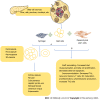Islet transplantation-immunological challenges and current perspectives
- PMID: 37388389
- PMCID: PMC10303418
- DOI: 10.5500/wjt.v13.i4.107
Islet transplantation-immunological challenges and current perspectives
Abstract
Pancreatic islet transplantation is a minimally invasive procedure aiming to reverse the effects of insulin deficiency in patients with type 1 diabetes (T1D) by transplanting pancreatic beta cells. Overall, pancreatic islet transplantation has improved to a great extent, and cellular replacement will likely become the mainstay treatment. We review pancreatic islet transplantation as a treatment for T1D and the immunological challenges faced. Published data demonstrated that the time for islet cell transfusion varied between 2 and 10 h. Approximately 54% of the patients gained insulin independence at the end of the first year, while only 20% remained insulin-free at the end of the second year. Eventually, most transplanted patients return to using some form of exogenous insulin within a few years after the transplantation, which imposed the need to improve immunological factors before transplantation. We also discuss the immunosuppressive regimens, apoptotic donor lymphocytes, anti-TIM-1 antibodies, mixed chimerism-based tolerance induction, induction of antigen-specific tolerance utilizing ethylene carbodiimide-fixed splenocytes, pretransplant infusions of donor apoptotic cells, B cell depletion, preconditioning of isolated islets, inducing local immunotolerance, cell encapsulation and immunoisolation, using of biomaterials, immunomodulatory cells, etc.
Keywords: B regulatory cells; Diabetes mellitus; Graft rejection; Immune tolerance; Islet transplantation; T regulatory cells; Type 1 diabetes.
©The Author(s) 2023. Published by Baishideng Publishing Group Inc. All rights reserved.
Conflict of interest statement
Conflict-of-interest statement: The authors declare no conflict of interest.
Figures

References
-
- Shapiro AM, Pokrywczynska M, Ricordi C. Clinical pancreatic islet transplantation. Nat Rev Endocrinol. 2017;13:268–277. - PubMed
-
- Khan K, Desai CS. Islet Transplantation in Children. Curr Gastroenterol Rep. 2019;21:26. - PubMed
-
- Ku HT, Zhang N, Kubo A, O'Connor R, Mao M, Keller G, Bromberg JS. Committing embryonic stem cells to early endocrine pancreas in vitro. Stem Cells. 2004;22:1205–1217. - PubMed
Publication types
LinkOut - more resources
Full Text Sources

